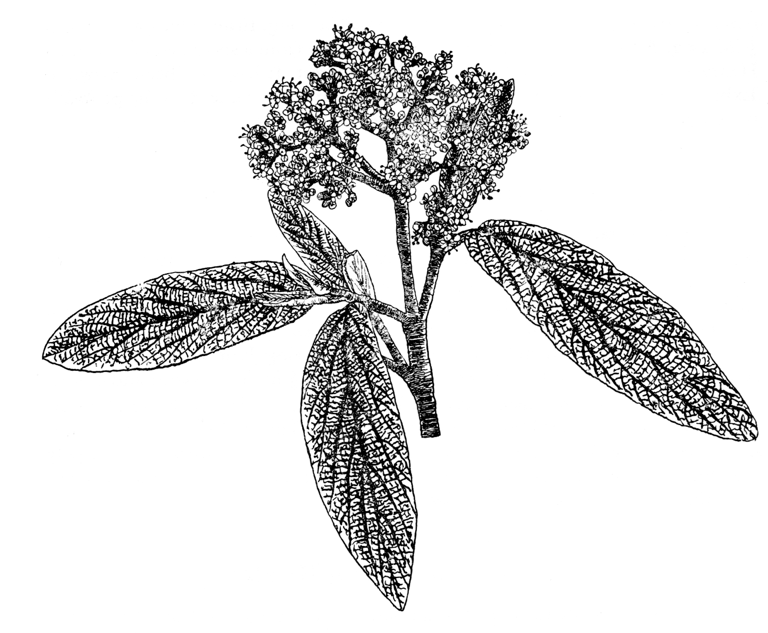An evergreen shrub 10 to 20 ft high, and more through; the stout branches thickly covered with starry down. Leaves ovate-oblong, 3 to 71⁄2 in. long, 1 to 21⁄2 in. wide, pointed or blunt at the apex, rounded or slightly heart-shaped at the base, upper surface glossy, not downy, but deeply and conspicuously wrinkled, lower one grey with a thick felt of starry down; stalk 1⁄2 to 11⁄4 in. long. Flowers produced on large terminal umbel-like trusses 4 to 8 in. across, which form into bud in the autumn and remain exposed all through the winter, and until the blossoms expand the following May or June. They are a dull yellowish white, about 1⁄4 in. diameter. Fruits oval, 1⁄3 in. long, at first red, then shining black. Bot. Mag., t. 8382.
Native of central and western China; introduced by Wilson for Messrs Veitch in 1900. It is hardy, and flowers well in spite of forming its inflorescences and partially developing them in autumn. Its beauty is in its bold, wrinkled, shining leaves; the flowers are dull and not particularly attractive. In previous editions it was called ‘one of the most distinct and striking, not only of viburnums but of all the newer Chinese shrubs.’ But this praise only applies to plants grown in a good soil and a sheltered position. Wind-tattered or starved plants are downright ugly, and are responsible for the execration in which this species is held by some gardeners. The plant at Borde Hill in Sussex, mentioned in previous editions as 20 ft high and 30 ft across, enjoyed an exceptionally good soil as it grew in the former kitchen garden.
f. roseum Hort. – Flowers pink in the bud, becoming white flushed with pink. This has probably been raised in several gardens. The name was originally given to a plant grown by Mrs Sebag-Montefiore in her garden near Plymouth (Gard. Chron., Vol. 104 (1938), p. 171 and supplementary illustration).
V. × rhytidocarpum Lemoine – A hybrid between V. rhytidophyllum and V. buddleifolium raised by Lemoine and put into commerce in 1936. It is of no horticultural interest.
V. × rhytidophylloides Suring. V. lantanophyllum Lemoine ex Rehder’s Manual – A hybrid between V. rhytidophyllum and V. lantana, said to occur fairly frequently among seedlings of the former when V. lantana is growing in the vicinity. The original clone, named ‘Holland’ was raised about 1925. It resembles V. rhytidophyllum but the leaves are larger and less wrinkled, almost deciduous.
V. rhytidophyllum × V. utile ‘Pragense’. – Leaves shorter than in the former, which was the seed-parent, elliptic or elliptic lanceolate, 2 to 4 in. long, glossy and slightly wrinkled above, felted beneath. The branchlets are more slender than in that species and the habit laxer. Raised by Josef Vik in the Municipal Nurseries, Prague, and named in 1959. Like the seed-parent it is hardy in Czechoslovakia, while V. utile is tender (Gard. Chron., Vol. 147 (1960), p. 317).


